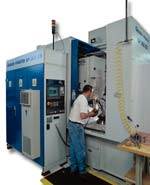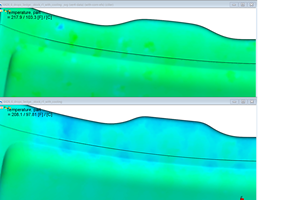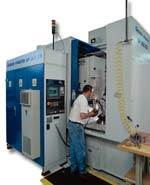Making Plastic Parts in Five Weeks
Massachusetts company uses innovative process to create medical parts with distinctive textures.
Casting is a process that usually brings to mind large foundries and molten metal being poured into steel molds. But just south of Boston an innovative company is moving into new territory by hand-pouring liquid resins into silicone rubber molds. The company is Polymer Liquid Resin Casting (LRC), a division of Polymer Corporation and the plastic casting process it has mastered has become a much sought after means to produce complex plastic parts very quickly (five weeks from concept to reality) and cost-effectively (thousands of dollars rather than tens of thousands).
Polymer Corporation consists of Polymer Tooling (Indianapolis, IN), Polymer Injection Molding (Monson, MA) and Polymer Liquid Resin Casting (Rockland, MA). The corporation specializes in rapid production of high-quality complex plastic parts for high-tech industries such as medical, semiconductor, scientific and electronic instrumentation, and defense.
"Polymer LRC makes short-run plastic parts and components and we're pretty unique in our approach," says Rick Gould, Polymer's engineering manager. "There are less than fifty companies in the country that do production plastic casting like we do."
Gould explains that three-quarters of the plastic parts that the company produces are for the medical industry. "We make grips, handles and brackets, often for very expensive medical equipment like magnetic resonance imaging (MRI) machines," Gould says. "So we're talking about any kind of device that a doctor or medical technician is going to hold in his or her hand." The challenge, Gould explains, is that the parts are often small and quite intricate, and there's a heavy emphasis on surface texture and aesthetics. "In years past," Gould continues, "people didn't react well to cold, metal components in hospital settings. So the industry has been moving towards producing more and more components made out of plastic, and putting a heavier emphasis on touch, feel and aesthetics."
Traditionally, plastic parts have been the domain of injection-molding companies, but that approach is cost-effective only in large runs. In recent years, another market segment has evolved called rapid prototyping - but so far the emphasis is on prototypes rather than runs of actual parts. Polymer LRC occupies the space in between, focusing on short runs of very high quality plastic parts. "We're talking about 500 or so pieces at a time," says Gould, "which would be cost-prohibitive to make using plastic injection molding. It's quite practical using a plastic casting process."
From Drawing to Aluminum Pattern
The process begins with Polymer LRC receiving a 2-D drawing or 3-D CAD model of a part from a client. Polymer's engineers go to work using the SolidWorks CAD program, and design a pattern based on that original geometry. The pattern, made of aluminum, is slightly larger to allow for shrinkage, features gates where the plastic resin will be poured into the mold, and has surface textures on it that will ultimately end up on the finished plastic parts.
Once the pattern is designed, it is transferred to the SURFCAM environment (SolidWorks has a built-in direct translator to SURFCAM) where Polymer LRC manufacturing engineers determine a machining strategy. "Ninety-nine percent of the jobs we machine are complex 3-D surfaces, so it was imperative that we have NC software with very powerful surface editing capabilities, and we found that with SURFCAM." He continues, "We've been using SURFCAM for about three years now, and it has definitely given us a competitive edge. Our engineers are confident that they can machine just about any part that we can throw at them."
The aluminum patterns are machined on several different kinds of mills including a Haas CNC machining center and a Bridgeport CNC machining center. The use of SURFCAM minimizes the number of machining setups that are required, dramatically reduces the amount of scrap, and allows Polymer LRC engineers to wrap textures onto the surfaces. "We have produced parts that have a beautiful polished surface, a leather-looking kind of finish, and just about everything in between," says Gould.
"What we do is unique," continues Gould. "If you go out looking for a company to make you a tool or a die, or to do some injection molds, you have a lot of places you can go. There are a lot of people who know how to do that. But there aren't many people that are used to machining patterns, because not many industries rely on them anymore. So it has become somewhat of a lost art."
Silicone Rubber Molds Key to Part Quality
The ability to deliver plastic parts with distinctive surface textures comes partly from SURFCAM's surface editing and wrapping capabilities, and partly from Polymer's decision to make its molds from flexible silicone rubber. "Silicone rubber is by far the best replicator on the market for capturing and reproducing textures," explains Gould. "Silicone is flexible, so we don't have to have a straight pull coming out of the mold. It lends itself to complicated part geometries with very nice textures."
One of the difficulties inherent in Polymer LRC's plastic casting process is that the plastic poured into the molds are particularly destructive to rubber. "The forty or fifty urethane resins we use attack the silicone," Gould explains. "Each time we pull a finished plastic part out of the mold, it tears away at the silicone. The heating process that we use to cure the urethane also takes its toll. We're typically able to get fifteen or twenty finished parts from each mold before the mold has to be replaced."
"Some of the engraving that we do with SURFCAM on complex surfaces is totally mind boggling to watch. If we had someone do that by hand, it would take him a year," says Gould.
As with any manufacturing operation, it's all about part quality, time and money - and SURFCAM is helping Polymer LRC on all fronts. "For our business to be successful, we knew that we had to have a software program that defined and machined surfaces extremely well," concludes Gould. "When it's all said and done, we need to have good surfaces that we can machine. And that's what we get with SURFCAM.
"It's a very fast product. In one test that we conducted, our previous NC program took four hours to verify toolpaths because it was geared towards solid geometry rather than surfaces. SURFCAM verified the same tool paths in five minutes, because it has been designed to work with surfaces. The difference was incredible," Gould continues. "SURFCAM also is a very strong product for toolpath verification. We're so confident that the toolpaths are accurate that we routinely run milling jobs unattended, overnight."
Learning 3-D Machining in Two Weeks As a deadline-driven company, Polymer LRC can't afford to take people offline for long periods of time in order for them to learn new technologies. And with SURFCAM, they didn't have to. "We have one machinist who had some background in CAD but no experience in 3-D machining. After taking the training from our Surfware dealer (DM Solutions, Salem, NH), he picked up SURFCAM in less than two weeks. He hit the ground running," notes Gould.
"The bottom line is that our customers win in all of this," Gould continues. "For about $5,000, we can make a pattern and molds and deliver about one hundred plastic parts. It's an economical solution for short-run products, which is what Polymer LRC specializes in. To try and do something like this at an injection molding shop, you'd be looking at startup costs of at least ten times that amount.
"We're happy that through the application of technology, we've come up with a solution that's truly meeting the needs of our customers," he says.
Not Resting on Its Laurels
Polymer LRC has no regrets about the course that it has taken, and the results that it has seen. In fact, the company eagerly looks towards the future - and new challenges. "The one tool that we are missing in this shop is a five-axis CNC because we keep talking about how complex the surfaces are, and how many setups we have to do," Gould concludes. "That would reduce our setup time. So that's what we may be focusing on next."
Related Content
True Five-Axis Machine Yields More Throughput, Greater Productivity
CDM Tool & Mfg. Co. LLC increased shop capacity thanks to a versatile high-speed/high-accuracy five-axis Fooke mill capable of cutting very large workpieces quickly and accurately with fewer setups.
Read MoreFive-Axis Graphite Mill With Automation Debottlenecks Electrode Machining
Five-axis electrode cutting enabled Preferred Tool to EDM complex internal screw geometry on an insert that otherwise would have had to be outsourced.
Read MoreQuickly Troubleshoot New Molding Defect with Moldfilling Software
SyBridge Technologies analyst compares original, new Moldflow process simulation results, solves molding defect without tool needing to be taken out of production.
Read MoreConsiderations for Mold Base Material Selection
Choosing the right material can greatly affect the profitability and cost of your application.
Read MoreRead Next
Casting For Customers
Gear shaping is a vital capability for job shops because it gives them the ability to handle jobs that can't be hobbed efficiently, like spur gears with narrow face widths, gears with close shoulders and the majority of internal gears.
Read MoreReasons to Use Fiber Lasers for Mold Cleaning
Fiber lasers offer a simplicity, speed, control and portability, minimizing mold cleaning risks.
Read MoreAre You a Moldmaker Considering 3D Printing? Consider the 3D Printing Workshop at NPE2024
Presentations will cover 3D printing for mold tooling, material innovation, product development, bridge production and full-scale, high-volume additive manufacturing.
Read More











.jpg;maxWidth=300;quality=90)








_300x250 1.png;maxWidth=300;quality=90)







